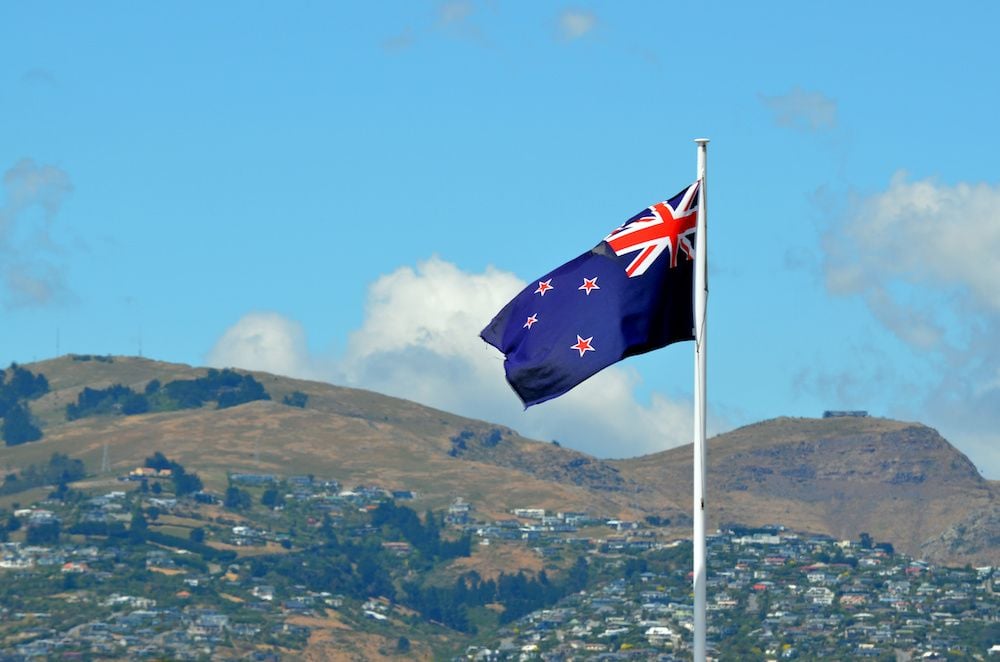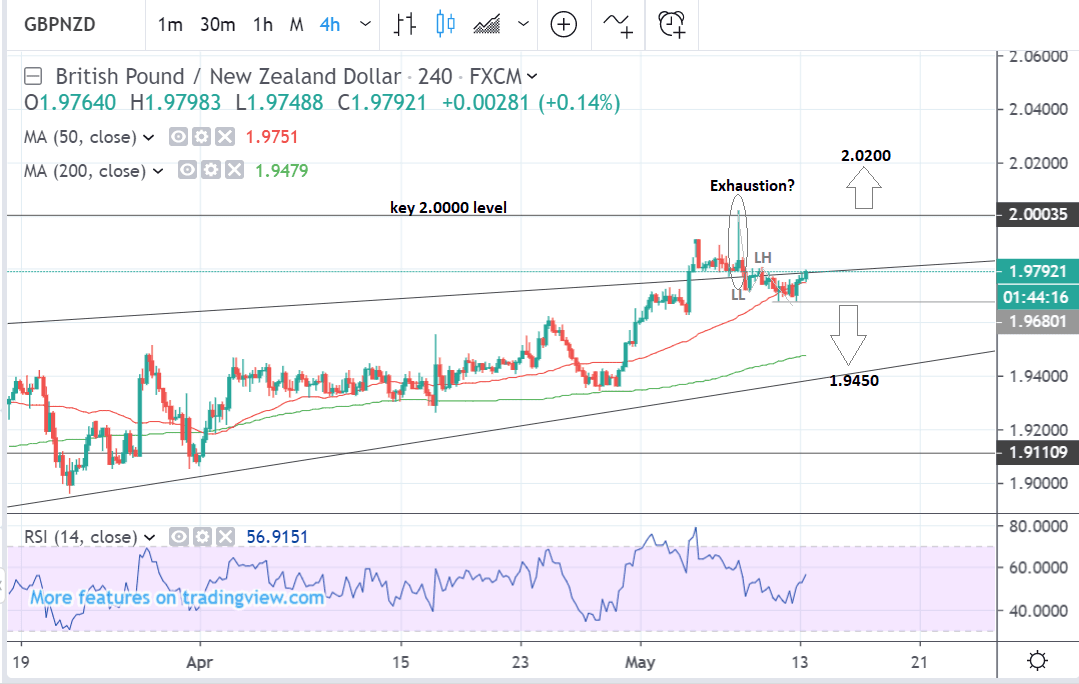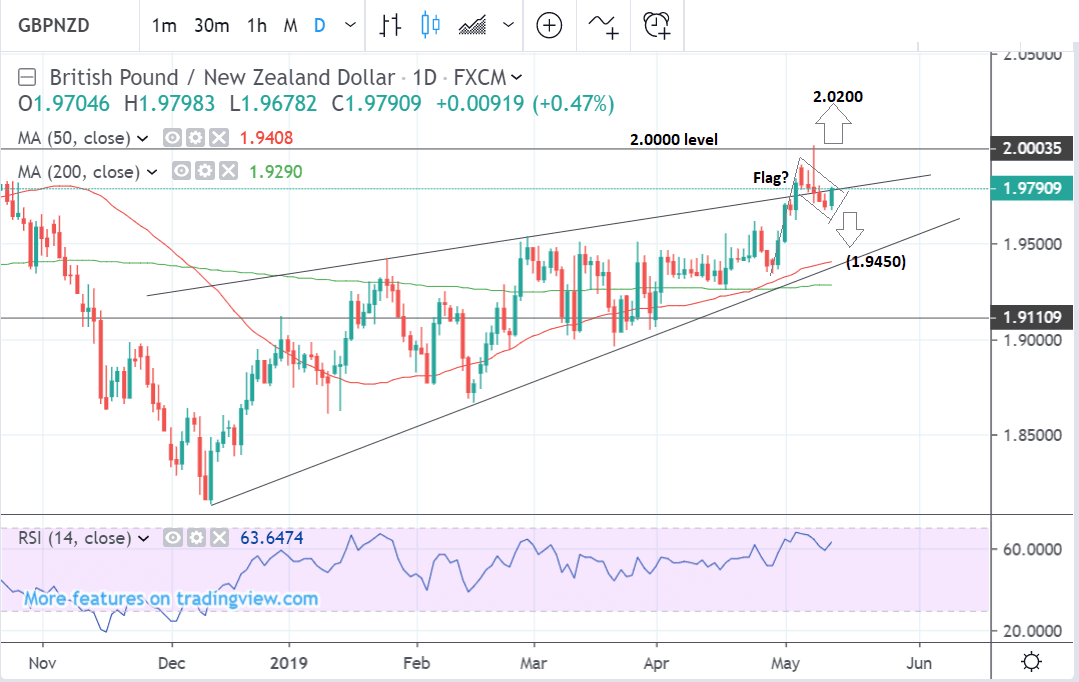Pound / New Zealand Dollar Week Ahead Forecast: 2.00 Might be as Good as it Gets

Image © Rafael Ben-Ari, Adobe Images
- GBP/NZD may have peaked after RBNZ rate cut
- But, more downside required for confirmation
- Cross party Brexit talks to influence Sterling this week
- Global risk trends, trade wars eyed by NZ Dollar
The Pound-to-New Zealand Dollar rate is trading at 1.9792 at the time of writing, on Monday May 13, after climbing almost half a percent already at the start of the new trading week. Last week, the exchange rate temporarily spiked above the pyschologically significant $2.00 level, hitting the target from our previous forecast.
The spike last week came in the wake of the Reserve Bank of New Zealand's decision to cut interest rates; the fall in the NZ Dollar did however prove short-lived and we are yet to see any substantial follow-through by currency traders in the wake of the decision.
The technical outlook is mixed, for whilst the exchange rate is technically still in a short-term uptrend, the spike higher which led to the establishment of the May highs, and saw the exchange rate briefly pierce the $2 mark, also looks very much like an exhaustion move, and possible reversal point.
In addition, the pair is currently hitting resistance from a major trendline which connects the January and February 2019 highs, and this could prove difficult for bulls to overcome.
Our forecast, therefore, is dependent on confirmation from a break above or below various key levels.
A break above that 2.002 May high, for example, would confirm an extension of the uptrend to an initial target 2.02.
Alternatively a break below the 1.9675 May 10 low would establish two or more lower lows (LL) and lower highs (LH) on the 4hr chart (above) which is the first sign of the onset of a new downtrend. This would also help confirm an extension down to a target at 1.9450 at the lower trendline of the recover move which began at the end of 2018.
The daily chart supports a more bullish outlook, if anything. Repair appears to have formed what looks like a bullish flag pattern, however, it is not particularly clear and there remains a question mark over whether it really is a bull flag or not. Nevertheless, it adds a bullish dimension to the chart.
The RSI momentum indicator in the bottom panel actually looks a little bit toppy and adds a slightly bearish timbre to the chart, however, momentum alone is not usually enough to base forecast on.
Time to move your money? Get 3-5% more currency than your bank would offer by using the services of foreign exchange specialists at RationalFX. A specialist broker can deliver you an exchange rate closer to the real market rate, thereby saving you substantial quantities of currency. Find out more here.
* Advertisement
The New Zealand Dollar: What to Watch
The main driver on the horizon for the New Zealand Dollar is likely to be global risk trends relating to the U.S.-China trade war.
Certainly, the advantage held by Sterling against the NZ Dollar at the start of the new week appears largely down to the negativity markets are expressing owing to the recent flare-up in U.S.-China trade tensions .
"Currencies with a heightened sensitivity to global trade and China’s economy struggled, weighing on the dollar bloc trio from Canada, Australia and New Zealand, along with emerging markets," says Joe Manimbo, a foreign exchange analyst with Western Union.
The Kiwi is especially sensitive to trade dynamics with China which is its largest trading partner and the state of the Chinese economy therefore has the ability to impact Kiwi values.
China has this week raised tariffs on a further $60bn of U.S. imports in retaliation for the U.S. tariff increase in the previous week.
"Unfortunately for all the hope of a last-minute compromise, we are now looking at the possibility of another bout of tariffs on $300 billion of Chinese goods as Trump takes aim at driving home the huge differential in trade between the two sides. With Trump angling for another four-year term, and the Chinese Foreign Minister promising that there will be ‘no surrender’ to foreign
pressure, thus there is a very real threat that the current setback is the beginning of yet another drawn out phase of the trade war as they seek to show strength domestically," says Joshua Mahony, Senior Market Analyst at IG.
The Chinese want a cessation of all current tariffs, which it is highly unlikely the U.S. will grant since they have worked at rebalancing the trade deficit, the main objective for introducing them in the first place. The Chinese also appear to be against the laws introduced with a view to preventing intellectual property theft, seeing these as an intrusion to sovereignty and a matter of national dignity.
Trump, meanwhile, reiterated his view that tariffs were good for America and he wouldn't be getting rid of them anytime soon unless China stuck to previously-agreed concessions.
Trump also indicated no intention to back down as he “loved tariffs”. He said the US is “right where we want to be with China”. And he criticised again that China “broke the deal with us & tried to renegotiate”. And the U.S. is taking in “Tens of Billions of Dollars in Tariffs”. He reiterated that the tariffs collected could be spend on “Great Patriot Farmers” and “distribute the food to starving people” in other nations.
Turning to domestic drivers of the New Zealand Dollar, the RBNZ cut rates from 1.75% to 1.50% at a policy meeting last week and this weighed on the Kiwi and was the principle reason why GBP/NZD spiked above $2.00 temporarily.
Although the central bank said it did not necessarily see the need for more rate cuts on the horizon, it did say it would be watching incoming economic data for signs of a further slowdown and if that was the case might cut rates further.
As such any NZ data could come under increased scrutiny as traders to try to second-guess the RBNZ's next moves.
There are no major releases on the horizon, but PMI surveys which are based on responses from pivotal purchasing managers within companies are scheduled for release.
Business PMI is expected to show a rise to 54.5 in April when it is released at 23.30 BST on Thursday, May 18. If it continues to show results over 50 it is sign businesses expect to expand which is positive for the economy.
A further release of importance is producer prices (PPI) in Q1. These are also known as ‘factory gate prices’ and they are scheduled for release at 23.45 on Thursday. Rises in inflation are usually preceded by increases in factory prices as measured by the PPI.
Higher inflation leads to higher interest rates and a stronger currency, so if PPIs show an increase it will contribute to a positive narrative for the Kiwi, even if there is no discernible impact immediately.
Time to move your money? Get 3-5% more currency than your bank would offer by using the services of foreign exchange specialists at RationalFX. A specialist broker can deliver you an exchange rate closer to the real market rate, thereby saving you substantial quantities of currency. Find out more here.
* Advertisement






